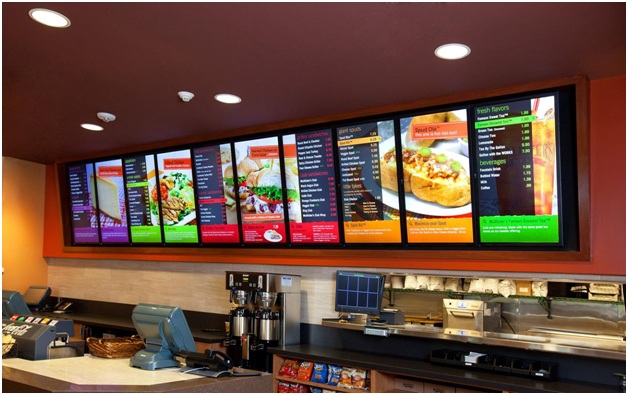While each digital signage installation project is unique and has to be handled case-by-case, there are certain characteristics that affect which affect every installation.
Outside of the core requirements for digital signage (software, hardware, and content), it’s important to be aware of the physical aspects to get the most ROI out of your digital signage project.
What Is A Digital Signage?
Getting every opportunity to advertise in physical spaces is crucial to a business’s success. One of the best ways to advertise to potential customers is through the use of digital or electronic signage. Digital signage is a display technology that exhibits content relevant to a business, which can be displayed through projection, LCD, LED, or e-paper.
Digital signages are best displayed on high-traffic public spaces, like the streets, bus and train stations, and shopping malls. Aside from its main advertising purpose, digital signages are also used to provide information in the following contexts:
- Corporate: training, meeting coordination, and knowledge sharing
- Public use: wayfinding, maps, and location-specific information such as news, weather, and traffic
- Restaurants and food businesses: self-ordering kiosks, digital menu boards, and self-service signage
Tourism: city information, wayfinding, and points of interest
Below, we’ve compiled a list of the three most common but integral aspects you should consider to make sure your digital signage installation is a success.
1. Selecting the correct digital signage hardware
Hardware selection (screens and players) can make or break your digital signage installation. Important factors to consider are:
- What kind of budget do you have?
- Where will the hardware be installed?
When choosing your screen, you have your choices of either commercial-grade or consumer-grade displays.
While cheaper, consumer displays often have limitations with the brightness (they are meant to be used at home after all), limited warranties, or not being able to handle the long play times that digital signage will need.
It is, therefore, best to invest in commercial-grade displays that will last longer and give you a better ROI.
For your media players, your options include simple USB-stick-like players like Amazon Fire Stick, standalone media players like Google Chromebox, or all-in-one solutions the system on chip (SoC). While all can deploy content to your screens, it is important to be aware of the limitations and benefits of both.
Connectivity will also play a role in the success or failure of your implementation. The media players need an internet connection in order to download content from the software and display it on your screens.
- Do you plan for a wired or wireless connection?
- Are you displaying live content that needs a constant internet connection?
- Is your cabling set up support these requirements?
However, keep in mind that your digital signage is more than just hardware. The right way to implement your electronic signage solutions should involve a combination of the tangible components and content inventory of text, graphics, audio, and video—which is how they’re presented.
Aside from purchasing the best hardware components like the screen, payment devices, and the like, make sure to find the right audio visual consulting services to help you strategize and care for your digital signage.
2. Distance, Height, & Positioning
Where you place your digital signage is the most important part to consider while planning your installation. Your screens should be at a height and angle that is easy to see for your audience.
After finding where to best place your signage, screen size is next.
Your distance and screen size are very intertwined, and while there are numerous guides online that can help you determine what size is best, the general consensus is that as you increase viewing distance, you will need to go for a bigger size.
Your screens should also be positioned so that it is easy for customers to look at your screen without having any glare. This is easily remedied by placing your screens in a place with sufficient lighting.
3. Physical Installation
Once you’ve chosen the hardware for your digital signage project comes the most physically demanding and stressful aspect; installing them.
While you could use a professional installer to set up your digital signage, here are the important aspects to consider during installation:
- When mounting your signage, you’ll want to start with the basics. First, will your signage need an enclosure? Enclosures are mostly made to protect the screens and are very useful for outdoor enclosures.
- What mounting style works best for where you are placing your signage? If this is a ground-level placement, such as a directory at a mall, you would need a pedestal mount. If your signage is placed on a ceiling or wall, you’ll want to consider how much your screen will have to swivel or rotate to fit into the optimal viewing angle.
Installing your first digital signage can be very stressful and intimidating. If it is too much, professional services are available to assist you.
By considering and implementing the tips above, you should be able to get your signage up and running quickly and efficiently and help maximize the ROI that digital signage will bring to your business.
